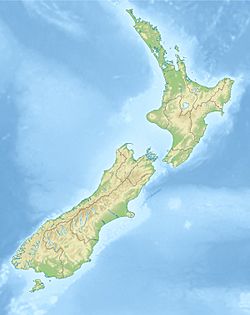1929 Arthur's Pass earthquake facts for kids
| UTC time | 1929-03-09 10:50:32 |
|---|---|
| ISC event | 907935 |
| USGS-ANSS | ComCat |
| Local date | 9 March 1929 |
| Local time | 22:50 NZST |
| Magnitude | 7.1 ML |
| Epicenter | 42°47′28″S 171°55′41″E / 42.791°S 171.928°E |
| Type | Oblique-slip |
| Areas affected | South Island New Zealand |
| Max. intensity | VIII (Severe) |
| Casualties | None |
The 1929 Arthur's Pass earthquake was a powerful earthquake that happened late at night on March 9, 1929. It shook the area around Arthur's Pass in New Zealand's Southern Alps. This region was not very populated back then. The main shaking lasted for four minutes. Smaller tremors, called aftershocks, continued for several days.
Scientists measured this earthquake at 7.1 on the Richter magnitude scale. This scale tells us how much energy an earthquake releases. The shaking felt in the area closest to the earthquake was rated as VIII (Severe) on the Modified Mercalli Scale. This scale describes how strong the shaking feels to people and how much damage it causes. Cities like Christchurch and Westport felt the shaking as VI (Strong). The earthquake happened on a hidden crack in the Earth's crust called the Poulter Fault. Scientists didn't find and map this fault until 2001.
Why Earthquakes Happen in New Zealand
New Zealand sits on the edge of two huge pieces of the Earth's crust, called plates. These are the Australian plate and the Pacific plate. These plates are always moving, but very slowly. When they rub against each other, they can get stuck. When they finally slip, it causes an earthquake.
In New Zealand's South Island, most of this plate movement happens along a big crack called the Alpine Fault. The Poulter Fault, where the 1929 earthquake happened, is about 50 kilometers long. It runs from the Bealey and Mahinga rivers to the Hurunui River valley. During the earthquake, a part of this fault, between 16 and 36 kilometers long, suddenly moved. It slipped sideways by up to 4 meters and also moved up by 1 to 2 meters.
What Happened After the Quake
The 1929 Arthur's Pass earthquake caused many landslides. These landslides damaged the Midland Railway and blocked roads. The main highway that connected Canterbury and the West Coast through Arthur's Pass was closed for several months. Many water tanks and chimneys in the area were also damaged or fell over.
Two years after the earthquake, people exploring the Otahake Valley found something amazing. A huge part of a mountain, about 900 meters high, had collapsed! It blocked the valley and sent rocks and dirt about 5 kilometers downstream.
Even though this was one of the ten biggest earthquakes on land in New Zealand since Europeans arrived, it was not as famous. This is because a few months later, the 1929 Murchison earthquake happened, which caused more deaths and damage.



